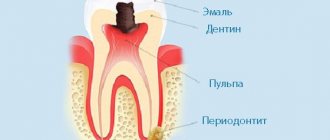Content
hide
1 Pulp - structure, functions, features
2 Why is a tooth without pulp considered dead?
3 How long does a tooth live without pulp?
4 What can lead to the need to remove a “dead” tooth: 4.1 There are several rules by adhering to which patients can prolong the use of the tooth:
Inflammation of the “nerve” of the tooth (pulpitis) is not always accompanied by severe toothache. A chronic infectious process can occur in a tooth unnoticed, leading to significant tooth destruction, the formation of a cyst on the root of the tooth, and even tooth loss. This pathology is an indication for tooth depulpation—removal of its “nerve.” Sometimes such news can come as a surprise to a patient if he did not suspect the presence of chronic pulpitis. At the same time, we are often asked - what will happen to the tooth later, after pulp removal? How long will the tooth live after this procedure, how will its condition change? We'll talk about this in the article.
Can a dead tooth hurt?
Before answering this question, let’s find out what the concept of “dead tooth” means? This is the common name for a tooth in which, for medical reasons, the pulp has been removed - loose fibrous tissue penetrated by nerve endings, blood and lymphatic vessels. We are talking about depulpation (removal of the pulp) in case of inflammation for various reasons: due to advanced caries, fistulas, cysts, etc.
Calling a pulpless tooth “dead” is not entirely correct. It is indeed separated from the circulatory system and the nervous system, but is still a component of the dentofacial apparatus, where each element affects the condition of the others.
Pain in a tooth with a removed nerve most often means that other parts of the system are involved in the pathological process, “transmitting” unpleasant sensations to the tissues associated with this tooth. Thus, a false impression is created that the pulpless tooth hurts.
Features of secondary caries of a previously pulpless tooth
A pulpless tooth is one in which the pulp (neurovascular bundle, or dental nerve) has been removed. Nerves are removed only when indicated - for example, in the treatment of complicated forms of caries or pulpitis.
The main purpose of the pulp is to protect surrounding tissues from inflammation and provide nutrition to the teeth and the entire oral cavity. When depulpation occurs, the tooth ceases to receive the necessary nutrition and becomes more fragile and vulnerable to any external influences. A tooth without a nerve is called a dead tooth. Despite this, with proper depulpation, it is securely attached to the gum, retains most of its functions and can serve its owner well. And yet, sooner or later, dead teeth without nutrition darken and decay. Careful attitude and proper maintenance help to extend their service life as much as possible.
Why does a dead tooth hurt when pressed?
Pain in a tooth without a nerve when biting or pressing can be due to various reasons, and is not necessarily explained by pathology. In the first days after depulpation, discomfort when pressing occurs as a reaction to the procedure itself.
It should be understood that nerve removal and preparation for filling is a microsurgical operation that is impossible without tissue injury. First, the dentist drills out the tooth cavity, then, using special tools - an apex locator and needles of various tapers - penetrates the root and extracts the nerve. Then anti-inflammatory and antibacterial drugs are placed into the cleaned channels.
Post-filling pain
If a filled tooth with a removed nerve hurts for some time, this may be normal, as it can be explained by objective reasons.
- In preparation for a filling, slight damage to the healthy tissue involved in the process may occur. Most often, this is the cause of pain in a dead tooth when pressed. Pains of this origin are called post-filling; they are moderate in nature and, as a rule, disappear after a few days. To relieve discomfort, the doctor usually prescribes painkillers.
- Unpleasant sensations may arise due to the characteristics of the filling material, which expands slightly when entering the root canals and creates pressure on the apex. These pains are temporary and disappear without a trace after a few days.
Intense pain in the tooth under the filling, its sharp increase a few days after the filling and the absence of a tendency to subside after one or two weeks are no longer the norm. This indicates the presence of complications and requires an urgent visit to the dentist's office.
Poorly performed treatment
The cause of pain in a treated tooth due to mechanical action (pressure, biting) may be errors made during endodontic treatment.
- Perforation of the tooth root.
Improper treatment can result in the filling paste extending beyond the root apex into the jawbone tissue. Inflammation under the tooth develops around the foreign body, causing first bursting and then throbbing pain. - Incomplete closure of root canals.
If the length of the canal is incorrectly assessed after filling, part of the cavity remains unfilled, infection develops in the voids, and as a result, when tapped, a tooth without a nerve hurts. - Incomplete depulpation.
If a tooth without a nerve hurts when pressed, this may indicate that the pulp was removed poorly and living tissue remains in the canals. - Poor saliva evacuation.
As a result, pathogenic microorganisms can enter the canal cavity along with the remaining saliva, which leads to tissue infection and pain. - A fragment of a tool in the canal.
Very thin needles used to examine tooth root canals sometimes break and some remain inside, serving as a source of pain and infection. - Specific root structure.
The condition for successful treatment is a completely sealed root system. Some branches, due to the non-standard structure of the apex, are not visible even on an x-ray, and then the dentist is not immune from making a mistake. - The filling is too high.
The ligaments that support the tooth experience increased stress, stretch, and discomfort and pain appear. - Poor quality removal of tissues affected by caries
, which are a source of pathogenic microflora and cause pain in the tooth under the filling.
Pain and swelling of the gums with quality treatment can also be caused by an allergy to a certain type of filling material. In such a situation, the dentist prescribes antihistamines and analgesics.
Cyst
If the nerve has been removed a long time ago—a year or more—and suddenly begins to hurt, the cause may be a root apex cyst. This disease occurs mainly in those teeth that have been subjected to depulpation and treatment. And since the pulp is removed during infection, the likelihood of a cyst subsequently forming is very high.
Inflammation of the trigeminal nerve
A situation where a filled tooth without a nerve hurts when biting or pressing can be caused by trigeminal neuritis. There is no mistake by the dentist here: inflammation can be caused by the treatment process itself. The pain can be constant, paroxysmal, throbbing. In this case, it is not the tooth that needs to be treated, so a neurologist deals with this problem.
Which is better: removal or treatment?
If on other teeth a carious lesion is an indication for treatment and removal is carried out only in case of serious complications, then when eights are affected the situation is always ambiguous.
It is not always possible to treat wisdom teeth caries. Mostly, treatment is used when the lower eights are affected, access to which is more free. Upper jaw caries of wisdom teeth is much more difficult to treat, since the dentist does not always have access to the center of the carious lesion and, even more so, cannot carry out high-quality cleaning and filling of the canals when the infection penetrates deeply.
For this reason, dentists often recommend removing decayed wisdom teeth if:
- the diseased molar is located on the upper jaw;
- caries is diagnosed at a deep stage;
- the tooth has crumbled and cannot be restored;
- there is no figure eight on the opposite jaw;
- the tooth is dystopic or impacted;
- the root system is twisted.
Wisdom tooth caries should be treated when the lesion is detected at the initial or middle stage, the tooth does not have any anomalies in eruption and formation, or it will serve as a support for the prosthesis during the planned prosthetics.
Pain under the crown when pressing
If after dentures there is pain under the crown of a dead tooth when biting, there may be several reasons. The tooth begins to hurt due to mechanical stress in the near future after prosthetics in the following situations:
- poor-quality filling, which was already mentioned earlier;
- due to incorrectly chosen shape or size of the crown, poor fit to the tooth;
- The fixation of the prosthesis is impaired due to an insufficient amount of cement: this allows food to get under the crown and the development of infection.
If pain does not occur immediately, but some time after installation of the prosthesis, this may be due to the following factors:
- violation of the tightness of the filling, crown;
- improper care of dentures and poor oral hygiene, which contributes to tissue infection and inflammation;
- the expiration date of the prosthesis (usually about 5 years).
Another reason for rapid tooth destruction under the crown, resulting in pain, is treatment with potent drugs for severe diseases, chemotherapy, and radiation exposure.
Attention! Unpleasant sensations without acute pain immediately after prosthetics are accompanied by the process of getting used to the crown. This goes away within two to three days after completion of the procedure. If the pain does not go away within the specified time, but rather intensifies, you need to urgently go to the doctor.
We correct other people's mistakes. Dental retreatment with a 10% discount
Moscow
For chronic and acute inflammatory processes
In most cases, tooth extraction is accompanied by acute or chronic periodontitis, inflammation of the gum tissue, or even the formation of purulent foci. If such a process covers a large area of tissue and is accompanied by high temperature, the formation of fistulas and edema, then most likely the attending physician will prescribe enhanced antibacterial therapy to slightly reduce the severity of inflammation. And only after this will surgery be performed in the oral cavity. On the other hand, there may be a need for immediate surgical intervention if the surgeon considers such intervention urgent. There can be many criteria for this choice, and only an experienced doctor can make an adequate decision.
What symptoms should you see a doctor for?
What to do if a tooth with a removed root hurts under the filling when pressed? During the first few days, do not panic and observe the nature and intensity of the pain. Pain during the week after filling may be a normal reaction of the body to surgical procedures. In what cases do you need to urgently contact the clinic?
- If within 5-7 days the pain does not go away, intensifies, changes its character to acute, pulsating;
- swelling of the gums appears;
- there is an increase in body temperature.
In such situations, you need to urgently see a dentist so as not to worsen the situation.
Diagnosis and symptoms of tooth root caries
Diagnosis of root caries is complicated by the fact that the disease can be asymptomatic for quite a long period of time. A visual examination of the oral cavity only in 11 - 13% of cases helps to identify the presence of the disease. Therefore, additional examination methods are required for diagnosis:
1) probing;
2) X-ray examination (orthopantomogram, radiography, etc.);
3) electrical odontometry (assessment of nerve response);
4) thermometry (checking the reaction to hot and cold).
It is impossible to identify the presence of dental root caries on your own, but basal or cervical caries, which in most cases accompany root damage, is quite possible. This can be done with a toothpick and a mirror. With clean hands, take a toothpick and pass it between the gum and tooth, pressing lightly. If pain occurs or roughness is found on the enamel, there is a possibility of developing caries of the cementum of the tooth root. This means it's time for you to visit the dentist.
Symptoms of root caries, which, as we noted above, may not always appear:
- pain when exposed to high/low temperatures;
- pain when eating sour and sweet foods;
- increased sensitivity of the periodontium;
- discomfort when chewing;
- aesthetic defect at the border with the gum.
What complications may arise?
Pain in a dead tooth necessarily indicates the presence of some pathology that needs to be eliminated in a timely manner. Infection can lead to serious consequences:
- complete destruction and death of the tooth;
- chronic gum inflammation;
- development of periodontitis, gingivitis;
- the appearance of cysts.
In addition, failure to seek medical help in a timely manner can lead to the development of systemic infections that spread from the periosteum through the bloodstream throughout the body!
Method of treatment
The use of analgesics numbs the pain, but when a dead tooth appears, a trip to the dentist is inevitable. Doctors will take therapeutic measures:
- remove the remains of decomposed pulp;
- root canals are filled with gutta-percha;
- restore the front part of the tooth with a filling or crown
Restoration of the coronal part is carried out using a filling, or a filling on a pin, in case of a large volume of lost tooth tissue. If the filling is ineffective, the doctor will install a crown or inlay.
The indication for pulp removal is its extensive inflammation, which threatens decomposition processes and further development of infection.
How to relieve pain at home
With moderate syndrome, you can cope with pain using traditional recipes.
- Rinsing with a soda-salt solution will help alleviate the condition; decoctions of medicinal plants: oak root, sage, chamomile, calendula.
- A paste of garlic and onion or a piece of propolis is applied to the diseased tooth.
- The submandibular area on the sore side is massaged for one and a half minutes.
For disinfection, rinsing with the antiseptics chlorhexidine and miramistin is recommended. In order not to endure severe pain while visiting the dentist, you can take medical anti-inflammatory and painkillers: aspirin, analgin, Ketanov, Nurofen; treat the problem area with Dentcos and Kamistad gels.
Important! You should not heat the affected area (this will increase inflammation), or use painkillers for a long time without a doctor’s prescription. All of the above measures will help temporarily relieve pain, but will not stop the process.
How long can a tooth be useful after depulpation?
As a rule, it is unusual for a tooth to be dead. The problem is not only the change in its color, but also its gradual destruction.
If the filling is placed poorly. Such a tooth can live for two to three years maximum, and in rare cases six or seven. However, if a tooth is filled by a highly qualified dentist, it can last more than ten years.
If the tooth has already begun to decay, then you should not be afraid of this either. A specialist will be able to put a crown on it that will serve you for many years.
Is it possible to cure a tooth on your own?
Remember: it is impossible to cure a tooth on your own, without the help of a specialist!
All means - medications, folk recipes - have only a temporary, disinfecting and alleviating effect. To get rid of pain, you need to make a correct diagnosis and eliminate the cause, and this can only be done by a dentist in a specialized medical institution using modern diagnostic and treatment technologies. Recommendations for self-treatment of a tooth under a filling can lead to the development of complications even faster.
Signs
If you heard a “dead tooth” from a doctor, then this name means that such a tooth has lost living tissue. Accordingly, only enamel and dentin remained from it. You can recognize it by the following signs:
- After you have undergone depulpation, the tooth becomes slightly grayish. However, in the future it will acquire a darker shade.
- The tooth stops reacting to everything cold and hot
- If a tooth is affected by caries, then there will be no pain even if something sweet gets into the damaged part of it.
- Slowly the tooth, which has acquired grayish and darker shades, begins to decay
Treatment of a dead tooth in dentistry
The treatment method for pain in a tooth with a removed nerve depends on the reasons that caused this condition. The dentist will conduct an examination and, if necessary, prescribe an x-ray examination.
- If the cause is unsatisfactory treatment, the filling material is removed, preparation is carried out again, and the canals are inspected with medications placed in them. Then, when the condition returns to normal, the tooth is refilled.
- If the roots are curved, it may be necessary to remove the part that prevents the canals from being cleaned and sealed.
- The cyst or granuloma must be surgically removed along with the pathologically changed tissues around it.
- If there is inflammation of the gums, complex treatment is prescribed. This includes professional teeth cleaning with stone removal, placing medications in periodontal pockets, and taking systemic medications.
- If indicated, physiotherapy procedures are prescribed that have a therapeutic effect on hard tissues.
Remember: by delaying a visit to the dentist, hoping that the pain will go away on its own, you increase the likelihood of serious complications, the treatment of which will be lengthy and possibly expensive.
Stuck root
The most common complication of tooth extraction can be a stuck, broken off root. If the root tip remains in the tissue, then the dentist has to use the entire arsenal of tools to get to the fragment: sometimes the tissue is drilled out or a section of the alveolus is removed to get to the desired depth. When hard tissues are crushed, this process can take quite a long time, since the dentist faces the difficult task of removing absolutely all the scattered fragments. In some cases this may take several hours.
Prevention
You should not think that a tooth with a removed nerve, deprived of blood supply, will relieve you of dental problems - you have already seen this. On the contrary, such teeth are problematic and therefore require more careful care. They are susceptible to any dental diseases - perhaps, except for pulpitis.
- The main means of prevention is thorough oral hygiene 2 times a day using a brush, dental floss, and mouthwash.
- A balanced diet containing enough vitamins and minerals will help keep your teeth longer.
- Regular visits to the dentist - at least once every 3 months - will make it possible to recognize the problem at the initial stage.
And remember: the best prevention of toothache is not to let the tooth need to be depulped, because the likelihood of subsequent complications is very high.
Author: Elena Kopylova Dentist-endodontist. Work experience more than 12 years.
The information is for reference only. Before treatment, consultation with a doctor is necessary.
Tooth root caries - treat or remove?
Just a few years ago, the answer to the question “Is it possible to cure tooth root caries?” would be definitely negative. The diagnosis suggested mandatory removal. However, today the situation has changed - modern drugs and methods for treating root caries make it possible not only to save the tooth, but also to prevent the disease.
However, if more than half of the root is damaged, removal will still have to be considered. Although even here there is a possibility that the tooth itself can be saved. The main methods of treatment that allow you to save a tooth in the presence of root caries: resection (removal of the affected root apex), amputation (removal of one part of a multi-rooted tooth), coronoradicular separation (separation of roots in the presence of caries in the branching area), hemisection (removal of the damaged part of the root together with an adjacent crown). The final decision as to whether the tooth can be saved is made by the attending physician based on diagnosis.
Reasons why the pulp dies
There are many reasons why pulp dies. Most often, it is removed when pulpitis has already developed, the nerve is inflamed, it no longer brings any benefit, but is only a cause of torment (this situation leads to the development of severe pain) and a source of infection. It is important to understand that an attempt to endure the pain from pulpitis, when a person uses various painkillers that relieve discomfort, but do not stop the destructive process, can also destroy a tooth.
Also on the list of reasons why pulp dies is injury. For example, if a person hit his jaw hard, and after that did not visit a doctor, leaving everything as it was. Against the background of such a situation, pain often persists for some time, and then gradually subside, while the tooth inside dies.
A tricky problem. What you need to know about toothbrushes and how to choose them? More details
What happens to such a tooth?
“Of course, such a tooth ceases to receive the microelements it needs, its resistance to bacteria is impaired, and over time it becomes fragile. But at the same time, it is worth understanding that such processes do not occur at lightning speed, but proceed very slowly, and such a tooth can remain in the oral cavity for many years,” notes Ilya Antonov.
Of course, certain rules of hygiene will help to preserve even a dead tooth: regular and correct brushing of teeth, the use of additional oral care products on the recommendation of a doctor, as well as preventive examinations according to the approved rules of dental medical examination.











